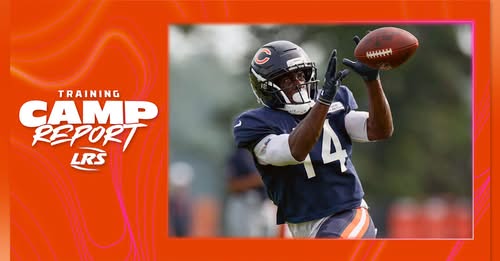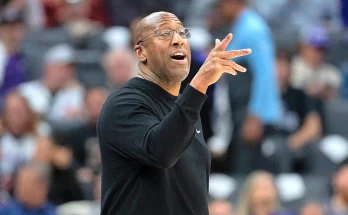Olamide Zaccheaus has consistently proven himself to be one of the most reliable and dynamic players on any roster he joins, but a recent practice session provided yet another vivid illustration of his clutch instincts and competitive fire. Late in practice, as the team prepared to wrap up their drills, the coaches called for a 2-minute drill scenario—a high-pressure situation designed to simulate the closing moments of a game where every second and every decision counts. It was here that Zaccheaus stepped up in a manner that left teammates and coaching staff not only impressed but deeply inspired.
The drill itself was a test of both skill and composure. Quarterbacks had to move the ball efficiently downfield while receivers, running backs, and offensive linemen executed their assignments with near-perfect precision. The clock was a relentless presence, ticking down with each snap, and the margin for error was minimal. In this environment, where even a small misstep could derail the play, Zaccheaus’ performance stood out not just for the physical skill he displayed, but for his mental sharpness and situational awareness.
From the very first snap, it was clear that Zaccheaus had his focus locked in. He demonstrated his trademark route-running precision, changing directions sharply and creating separation from defenders in a way that made the quarterback’s job noticeably easier. In drills like these, chemistry between the quarterback and receivers is crucial, and Zaccheaus’ timing and anticipation were near flawless. He seemed to have an innate understanding of what his quarterback needed, adjusting his speed, angle, and positioning to ensure that each pass opportunity was maximized. His awareness of the clock and the field’s spatial dynamics allowed him to navigate crowded coverage with confidence, turning potential obstacles into opportunities.
What made Zaccheaus’ performance even more remarkable was the context of the drill. By this stage in practice, fatigue had set in for many players. Muscles were sore, energy levels were dipping, and attention spans could easily wander. But Zaccheaus appeared to thrive under these conditions, channeling the pressure and fatigue into focus and execution. Each route was crisp, each catch secure, and each adjustment he made demonstrated not only his physical conditioning but also his mental resilience. Coaches often emphasize that true performance emerges not when conditions are ideal, but when players are tested to their limits—and Zaccheaus’ effort was a textbook example of this principle.
The drill progressed rapidly, and as the final minute approached, the intensity ratcheted up. Defensive players were executing aggressive coverage, applying pressure, and trying to disrupt timing patterns. It was a scenario that mimicked the chaos and unpredictability of a real game’s closing moments. Zaccheaus, however, remained unflappable. He displayed a remarkable ability to read the defense in real-time, adjusting his routes subtly yet effectively to exploit openings. His hands were steady under pressure, securing passes even in tight coverage, and his footwork allowed him to maintain balance and positioning in ways that made the difference between a completion and a dropped opportunity.
Teammates took notice immediately. The energy around the drill shifted as Zaccheaus consistently delivered clutch plays. Younger players looked on, absorbing both the technical execution and the calm demeanor he exhibited under pressure. Veteran players nodded in appreciation, recognizing the rare combination of skill, instinct, and poise he brought to a moment that could easily have unraveled into mistakes. Coaches were equally impressed, noting that while many players can execute drills in controlled scenarios, Zaccheaus’ ability to thrive in a high-stakes, time-sensitive environment marked him as a special contributor to the team’s overall performance.
It wasn’t just about the big catches or the speed with which he navigated the field; it was also about leadership by example. By maintaining focus, demonstrating situational awareness, and executing under pressure, Zaccheaus implicitly communicated a standard of excellence to the entire team. In practice, drills are often repeated numerous times, and it is easy for intensity to wane or attention to drift. Zaccheaus’ performance kept the energy high, setting a tone that encouraged everyone else to elevate their game. His presence in that 2-minute drill became a rallying point, a moment that reminded everyone why preparation, focus, and mental toughness are as important as raw talent.
Another key element of Zaccheaus’ showing was his adaptability. Defenses in practice are often unpredictable, simulating different schemes and coverages to prepare the offense for anything they might encounter in a game. In this drill, Zaccheaus had to make split-second decisions: when to break off a route, when to push for additional yardage, and when to settle for a safer option to maintain possession and clock control. His instincts allowed him to process these variables almost instinctively, translating defensive movements into actionable adjustments that consistently benefited the offense. In essence, he acted as both a receiver and an on-field strategist, reading the field in a way that few others could.
The final seconds of the drill brought the highest pressure. With just moments remaining on the clock, Zaccheaus found himself in a situation where one successful execution could make the difference between success and failure. He ran a precise out route, creating separation just enough to allow the quarterback a clean window for the pass. The ball arrived perfectly in his hands, and Zaccheaus turned upfield immediately, securing additional yardage before the simulated end-of-play whistle blew. The drill concluded, but the impact of his performance lingered long after. Coaches and teammates alike praised his ability to elevate the moment and deliver when it mattered most.
Zaccheaus’ display in this late practice drill highlights an important aspect of athlete development that extends beyond measurable statistics. While metrics like yards, receptions, and touchdowns are essential for evaluating performance, the ability to perform under pressure, maintain composure, and make intelligent, split-second decisions is equally critical. These intangible qualities often separate good players from great ones, and Zaccheaus demonstrated that he possesses them in abundance. His combination of technical skill, mental acuity, and leadership in high-pressure situations is a model for teammates and an asset for any team strategy moving forward.
Moreover, the significance of this moment extends beyond just one practice session. Late-game drills, like the one Zaccheaus excelled in, are designed to replicate scenarios that are pivotal in real games—scenarios that can define seasons, playoff runs, and even careers. By consistently performing in these controlled high-pressure situations, Zaccheaus not only strengthens his own readiness but also instills confidence in his teammates and coaching staff that the offense can rely on him in the moments that truly count. Such dependability is invaluable, and it is a trait that often distinguishes those who achieve long-term success in professional football.
Reflecting on Zaccheaus’ approach during the drill, several elements stand out as key to his success. First, his preparation is evident in every step he takes and every decision he makes. Execution under pressure is rarely a matter of chance; it is built on countless hours of practice, study, and repetition. Second, his mental toughness allows him to thrive where others might falter, converting stress and fatigue into focus and determination. Third, his ability to elevate the performance of those around him underscores his leadership potential, demonstrating that individual excellence can inspire collective achievement.
In sum, Olamide Zaccheaus’ performance in the 2-minute drill late in practice was more than just a display of athleticism. It was a showcase of precision, focus, adaptability, and leadership under pressure. Every route, every catch, and every adjustment he made reflected an athlete who understands the importance of timing, awareness, and composure. Coaches and teammates alike left that practice session with renewed confidence, knowing that when the clock is winding down and stakes are at their highest, Zaccheaus is a player who can be counted on to deliver. His ability to shine in such moments cements his reputation not only as a skilled receiver but also as a dependable, intelligent, and inspiring presence on the field. As the team moves forward, the lessons from that drill—resilience, focus, and clutch performance—will resonate, and Zaccheaus’ example will serve as a standard for what it means to step up when it matters most.


